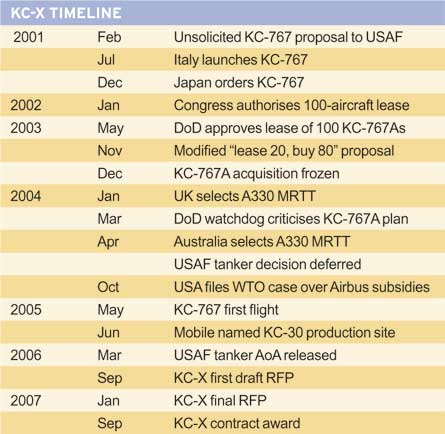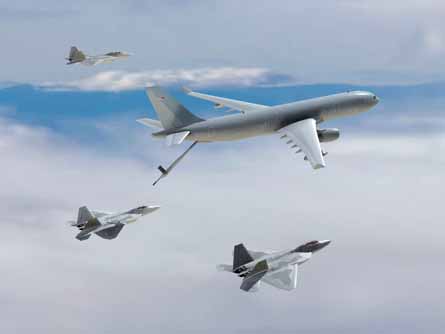US tanker and transport competitions to be decided over the coming months pose difficult buying choices, and promise to shape the market for years ahead
There are devils in the details when it comes to the latest US tanker and transport procurements. The KC-X replacement tanker, Joint Cargo Aircraft (JCA) and emerging combat rescue tanker requirements are bringing dissimilar aircraft from US and European manufacturers into head-on competition, and the Pentagon's "best-value" source selection process is under scrutiny like never before.
|
|---|
The KC-30 is based on the A330 multirole tanker/transport (MRTT) selected by Australia and the UK |
Whether there would even be a competition for the US Air Force's 179-aircraft KC-X was in doubt until last week, and hinged on the fine print in the final request for proposals (RFP) released on 30 January. But Northrop Grumman decided to bid because it now believes the evaluation process detailed in the RFP gives its Airbus A330-based KC-30 a chance to compete with Boeing's smaller KC-767.
The intricacies of the army and the air force working together to make a best-value determination between dissimilar aircraft could also bedevil source selection for the 145-aircraft JCA programme, which pits the Alenia Aeronautica C-27J against the EADS Casa C-295. Respective team primes L-3 Integrated Systems and Raytheon submitted their final proposals at the end of January, ahead of a May decision.
A third procurement is just getting under way, with interested bidders replying by last week to a "sources sought" notice for a 115-aircraft programme to replace Lockheed Martin HC/MC-130 combat rescue tankers flown by US Air Force Special Operations Command. Lockheed has proposed the KC-130J and L-3 and Alenia the C-27J, while the requirement has given EADS an opportunity to offer the Airbus Military A400M.
In each case these competitions involve existing platforms, with inherently dissimilar capabilities, being evaluated against a set of requirements. As the KC-X saga shows, exactly how those requirements are written, and precisely how the evaluation is to be conducted, can be as important as the capabilities of the platforms themselves.
Competitive advantage
In Northrop's judgement, its KC-30 can be competitive with the KC-767 under the rules of the KC-X game. But it had threatened not to bid, which would have left the USAF back where it began when Boeing first submitted an unsolicited proposal for the KC-767 in early 2001 (see table below). The intervening six years saw the 9/11 attacks a 100-aircraft KC-767 lease approved then rejected in Congress and a procurement scandal that finally killed the programme.

The tanker requirement was revived in January 2005, when an analysis of alternatives (AoA) dismissed leasing and recommended buying medium or large commercial aircraft to replace the USAF's 531 Boeing KC-135s. The AoA emphasised there was no urgency, but the air force restarted its programme within three months.
EADS North America moved equally quickly in 2005, selecting Mobile, Alabama as its KC-30 assembly site and teaming with Northrop to prime its KC-X bid. But, initially encouraged by the AoA's equanimity on the Airbus versus Boeing issue, grew increasingly concerned as the KC-X requirement solidified.
Initial concerns centred on the USAF's request that bidders identify the potential impact on the KC-X of any penalties that could result from the US-European World Trade Organisation dispute over Airbus and Boeing subsidies. This demand was removed from the second draft of the RFP, issued in December last year.
What the second draft did not resolve were Northrop's concerns over how the KC-30's greater cargo and passenger capacity would be evaluated against requirements baselined on the KC-135's limited airlift capability. The final RFP emphasises that the KC-X is a replacement for the KC-135, with aerial refuelling as its primary role, and details how the USAF will evaluate and score airlift capabilities beyond the threshold.
Northrop and EADS finally announced last week that they would submit a KC-X bid by the 2 April deadline. Boeing, meanwhile, is expected to offer the KC-767, rather than the KC-777 design it began developing after the tanker AoA opened the door to a larger aircraft. The KC-777 could still be a contender for USAF's longer-term KC-Y and KC-Z requirements, which would include replacing its Boeing KC-10 tanker/transports. While the KC-30 is based on the A330 multirole tanker/transport (MRTT) selected by Australia and the UK, the USAF KC-767 would be based on the aircraft under development for Italy and Japan. While KC-30s would be assembled and completed in Mobile, and use EADS-developed refuelling booms produced in the USA, KC-767s would be assembled in Seattle and completed in Wichita, Kansas.
Joint platforms
The Department of Defense's fiscal year 2008 budget request funds the KC-X, but reduces planned procurement from 15 aircraft a year to 14, stretching this first tranche of the KC-135 replacement programme over almost 20 years. The budget also funds both army and air force purchases of the JCA intra-theatre transport, with combined procurement planned to reach 25 aircraft a year by FY2012.
Begun by the US Army as the Future Cargo Aircraft, using funds released by its cancellation of the Boeing/Sikorsky RAH-66 Comanche combat helicopter, the JCA became a joint programme early last year. The services agreed to use the same platform, with the army leading acquisition and the air force source selection - an unusual arrangement for a US fixed-wing aircraft programme. The original requirement to replace US Army Shorts C-23 transports drew offers of the EADS Casa CN-235 and C-295 and Alenia C-27J. But the JCA's appeal to conspiracy theorists was cemented when Lockheed entered the competition with the larger C-130J - already operated by the USAF - only to be rejected by the US Army along with the smaller CN-235. Lockheed protested, but its rejection was upheld in November, reducing the JCA contenders to two.
Partnering network
Having formed the Global Military Aircraft Systems (GMAS) joint venture to offer the C-27J in North America, L-3 and Alenia subsequently added Boeing to their JCA team, with responsibility for final assembly in Jacksonville, Florida. Raytheon and EADS, meanwhile, picked Mobile - a different airport this time - as the final assembly site for both CN-235s and C-295s for North American customers.
After submitting their final JCA proposals, the teams promoted the differing strengths of their dissimilar aircraft - Raytheon/EADS pushing the C-295's lower acquisition and operating costs L-3/Alenia emphasising the C-27J's higher performance and interoperability with the C-130J. With pundits painting the C-295 as "army" and the C-27J as "air force", the pressure is on those now evaluating the rival bids.
Since becoming a joint programme, JCA has struggled with the gap in timing between the services' acquisition plans. First to finalise its requirements, the army is on track to complete source selection by March, but the USAF has still to complete the definition of its unique mission requirements, and the winner may not be revealed until after the Defense Acquisition Board meeting scheduled for early May to approve low-rate initial production.
The US Army requires civil certification and first delivery of its JCA within a year of contract award, and both Alenia Aeronautica and EADS Casa have begun long-lead work at their own risk to protect the schedule. The army's first two aircraft were funded in FY2006, and air force procurement is to begin in FY2010 with eight aircraft. Plans call for annual production to stabilise at seven for the army and 18 for the air force against requirements for 70 and 75, respectively.
The HC/MC-130 recapitalisation programme, meanwhile, provides EADS North America with its first opportunity to offer the A400M to the US military. While the European airlifter was rejected by Canada because it did not meet the delivery deadline, the A400M on its current development schedule meets the timing of the US special operations requirement, which calls for first deliveries in FY2011.
Alenia North America confirms GMAS plans to offer the C-27J, arguing its proposed tanker derivative of the twin-turboprop is well suited to refuelling the USAF's combat search-and-rescue helicopters. But special-operations commanders publicly talk of the need for a "C-130-sized aircraft", while also mentioning the A400M as a candidate. An industry day for the HC/MC-130 "recap" programme was held last week.
One key caveat in the sources-sought notice for the combat rescue tanker is that the amount of foreign involvement allowed "has not been determined". There is a risk that the sensitive special-operations requirements could bar a foreign-built platform, although the DoD has already taken the unprecedented step of selecting a European aircraft - the AgustaWestland EH101 - as the basis of its next US Presidential helicopter.
For Lockheed, the HC/MC-130 replacement is a key competition to win, although the DoD's budget plans promise to keep the C-130J line busy. The latest funding request makes clear that production of the improved Hercules will continue beyond the current multi-year contract, which ends in FY2008. In addition, money for 29 additional USAF C-130J tactical transports and US Marine Corps KC-130J tankers is included in the separate FY2007 emergency supplemental and FY2008 "global war on terror" funding requests submitted to Congress at the same time.
Strategic lobbying
Problems with Boeing's C-130 avionics modernisation programme (AMP) could also benefit the new-build J. The US Air Force was forced to inform Congress last week that the AMP upgrade has exceeded unit-cost growth thresholds, and it may have to restructure the programme. If the cost growth is serious enough, the DoD may have to recertify that the upgrade programme is still required.
The future looks less rosy for Boeing's C-17 strategic transport. Despite Congress adding funds for 10 additional aircraft in FY2007, in FY2008 the DoD again seeks to end production. Instead, several hundred million dollars is budgeted to relocate and store the production tooling. Boeing says deliveries will end in mid-2009 under existing and pending orders for the USAF, Australia, Canada, NATO and the UK.
Boeing is expected to mount an intense lobbying campaign similar to that which, at the eleventh hour, saved the C-17 last year. But the US Air Force has shifted its focus to aerial refuelling, intra-theatre transport and special operations - and the strategic airlift mission has taken a lower priority. With the mounting wartime demands on US defence spending, Congress may not be so ready to listen this time.
The same funding pressures could make any source selection missteps costly. With the KC-X programme already under intense Congressional scrutiny, and JCA on the watch list, the next few months could shape the tanker and transport markets for decades ahead.
Source: Flight International

















